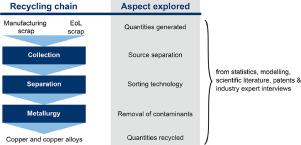Resources, Conservation and Recycling ( IF 13.2 ) Pub Date : 2021-02-24 , DOI: 10.1016/j.resconrec.2021.105462 Antonia Loibl , Luis A. Tercero Espinoza

|
This paper examines the copper recycling chain - from scrap generation through to metallurgical recovery - in search for current challenges and technological opportunities for improvement. We provide an analysis of global copper flows, showing largely constant amounts of recycled copper and a rise in importance of the complex end-of-life (EoL) scrap compared to the less challenging manufacturing scrap. Source separation of EoL scrap as an answer to waste complexity is examined but dismissed as not viable. A literature review on developments in sorting and separation technology revealed new promising possibilities through sensor-based technologies. However, examples for their use for tasks specific to copper recycling are rare and far from market-ready. Metallurgical recovery of copper has not experienced major developments in the last years. In particular, there is no easy solution for the removal of lead when remelting copper alloys. Interviews with experts from the copper recycling industry revealed that the handling and processing of copper scrap differs widely between companies but also between Europe and North America. While extensive scrap testing and load optimization is common practice for the copper industry in Europe, a discussion on the responsibility for scrap composition and consequently for the burden of scrap analysis is underway between scrap dealers and copper recyclers in North America. Scrap availability and optimization of the recycling chain as a whole are also important topics. A more coordinated optimization approach between actors along the recycling chain could potentially reduce overall costs and increase recovery of copper and its alloys.
中文翻译:

铜回收中的当前挑战:将材料流分析的见解与技术研究的发展以及欧洲和北美的行业问题相结合
本文研究了从废料产生到冶金回收的铜回收链,以寻找当前的挑战和改进的技术机会。我们提供了对全球铜流量的分析,显示出与回收率较低的制造业废料相比,回收铜的量基本保持不变,复杂的报废(EoL)废料的重要性也在提高。已对EoL废料的源头分离进行了分析,以解决废物的复杂性,但认为不可行。有关分选和分离技术发展的文献综述揭示了通过基于传感器的技术带来的新希望。但是,将其用于特定于铜回收的任务的例子很少,并且远未投放市场。铜的冶金回收在最近几年没有经历重大的发展。特别地,在重熔铜合金时,没有简单的解决方案来去除铅。铜回收行业专家的访谈显示,公司之间以及欧洲和北美之间的废铜处理和加工差异很大。尽管广泛的废料测试和负载优化是欧洲铜业的普遍做法,但北美的废钢经销商与铜回收商之间正在就废料成分的责任以及由此产生的废料分析负担进行讨论。废料的可用性和整个回收链的优化也是重要的主题。沿着回收链的参与者之间采取更协调的优化方法可能会降低总体成本并提高铜及其合金的回收率。重熔铜合金时,没有简单的解决方案来去除铅。铜回收行业专家的访谈显示,公司之间以及欧洲和北美之间的废铜处理和加工差异很大。尽管广泛的废料测试和负荷优化是欧洲铜业的普遍做法,但北美的废料经销商与铜回收商之间正在就废料成分的责任以及废料分析的负担进行讨论。废料的可用性和整个回收链的优化也是重要的主题。沿着回收链的参与者之间采取更协调的优化方法可能会降低总体成本并提高铜及其合金的回收率。重熔铜合金时,没有简单的解决方案来去除铅。铜回收行业专家的访谈显示,公司之间以及欧洲和北美之间的废铜处理和加工差异很大。尽管广泛的废料测试和负荷优化是欧洲铜业的普遍做法,但北美的废料经销商与铜回收商之间正在就废料成分的责任以及废料分析的负担进行讨论。废料的可用性和整个回收链的优化也是重要的主题。沿着回收链的参与者之间采用更协调的优化方法可能会降低总体成本并提高铜及其合金的回收率。



























 京公网安备 11010802027423号
京公网安备 11010802027423号